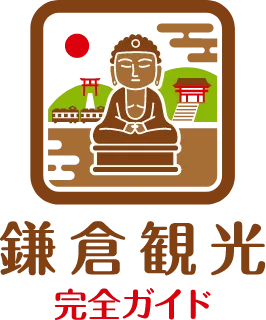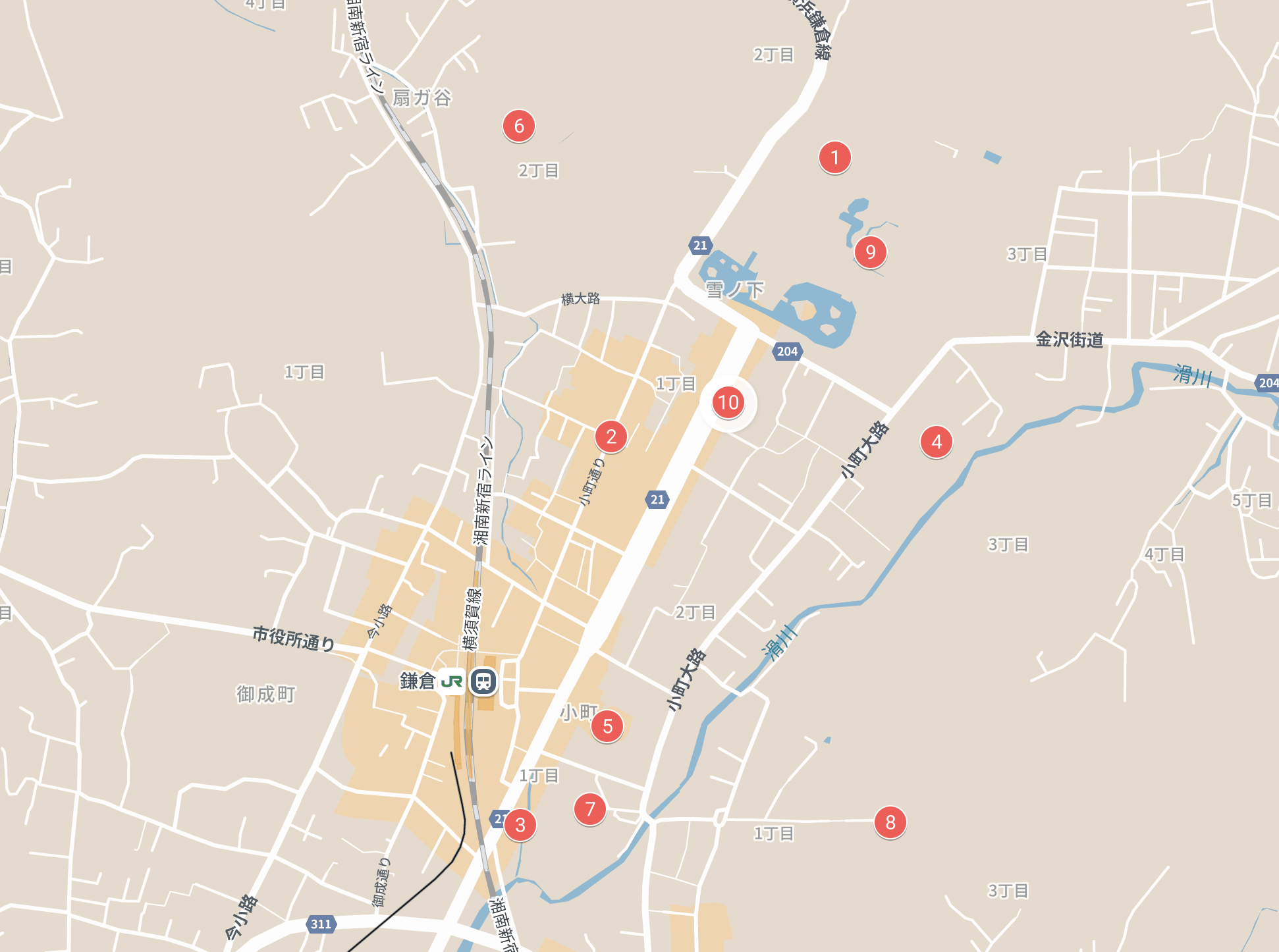AREA
A
AREA
A
Kamakura Sta. East Exit Area
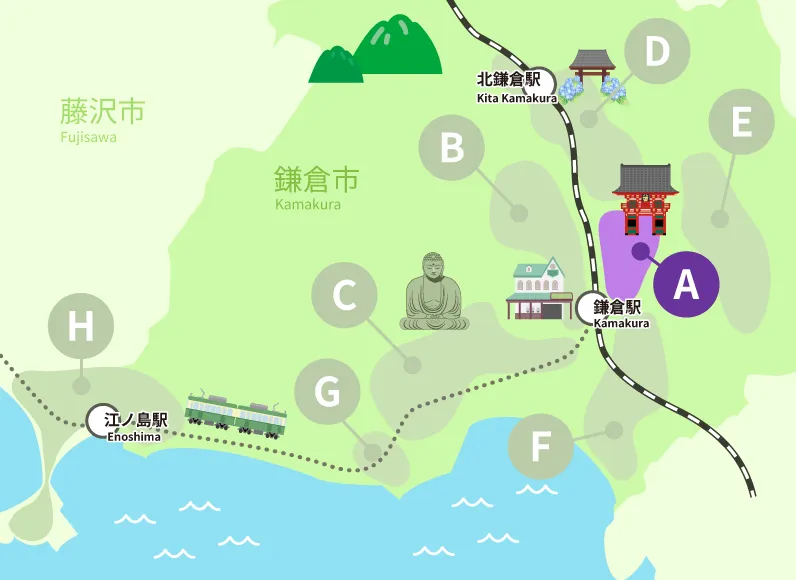
From the bustle of Komachi-dori to the tranquility of Tsurugaoka Hachimangu Shrine. A timeless shopping and spiritual cultural journey. Every visit is a new discovery.
Toshi’s Kamakura sightseeing map
- Tsurugaoka Hachimangu Shrine
- Komachi Street
- Kamakura City Agricultural Cooperative Sales Office
- Hokaiji Temple
- Daikoji Temple (Onmesama)
- Jokomyoji Temple
- Hongakuji Temple
- Myohonji Temple
- Kamakura Museum of National Treasures
- British Antique Museum BAM Kamakura
Features
The East Exit area of Kamakura Station is a vibrant gateway to the city, filled with bustling shopping streets and a variety of restaurants.
Komachi Street, a charming blend of traditional and modern, features over 250 shops offering everything from classic souvenirs to the latest fashion items.
Strolling through this lively street allows you to experience Kamakura’s rich culture and flavors up close.
Tsurugaoka Hachimangu Shrine, established as a spiritual center of Kamakura by Minamoto no Yoritomo, is another highlight of the area.
Known for blessings like good fortune, success, and matchmaking, the shrine also features unique architectural elements such as its dual structure and grand staircase.
It conveys messages of peace and hope while offering a glimpse into Kamakura’s historic roots.
For fresh local produce, don’t miss the Kamakura Farmers’ Market (Renbai).
Here, you’ll find seasonal Kamakura vegetables and other fresh items that are beloved by locals and visitors alike.
If history intrigues you, visiting temples such as Hokai-ji, Daigyo-ji, Jokomyo-ji, and Hongaku-ji is highly recommended.
These temples reflect Kamakura’s historical and spiritual essence, offering tranquil experiences for visitors.
Each has unique features, like Daigyo-ji’s reputation for safe childbirth prayers, making them deeply memorable.
The East Exit area of Kamakura Station condenses the essence of Kamakura, where tradition and modernity blend seamlessly.
With new discoveries each visit, it remains an enchanting area to explore again and again.
Sightseeing Spot
-
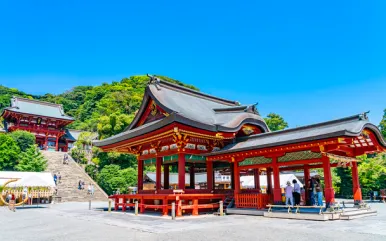
Tsurugaoka Hachimangu Shrine
Witness of history
Sacred power that protects KamakuraIt was established as the spiritual center of Kamakura by Minamoto no Yoritomo. As the main shrine of the Kamakura shogunate, it was the spiritual support of the samurai in the capital, and has a distinctive structure consisting of two upper and lower areas, including the Oishi steps and Wakamiya. It is said to be blessed with blessings such as good luck, family safety, prayers for victory, and improved luck at work, and is also famous as a place for matchmaking. Through traditional events, we convey a message of peace and hope along with the breath of history to visitors.
-
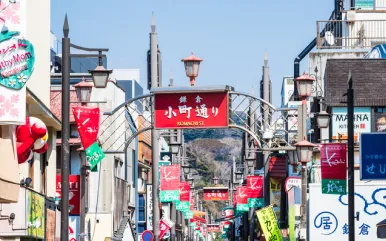
Komachi Street
A street where Kamakura's traditions and
trends intersectThis is a lively shopping street that runs from Kamakura Station to Tsurugaoka Hachimangu Shrine. There are over 250 stores, offering a wide range of products from traditional souvenirs to the latest fashion.
-
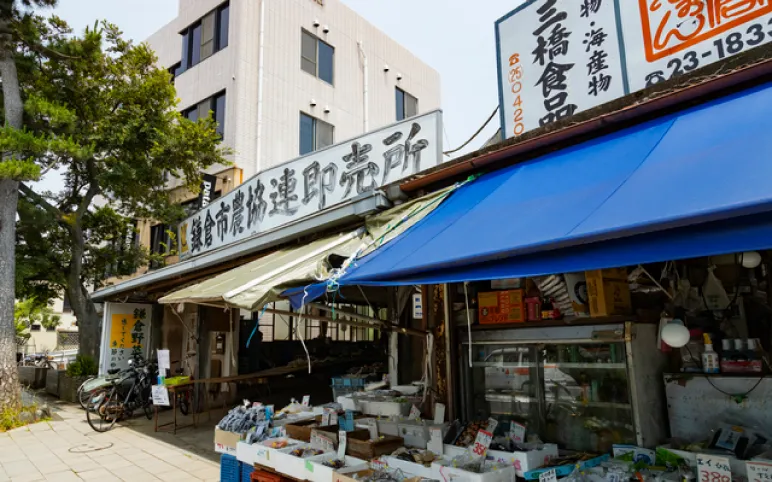
Kamakura City Agricultural Cooperative Sales Office
The birthplace of Kamakura vegetables
A journey to sell directly from local farmersKamakura City Agricultural Cooperative Federation Sales Office (Renbai) is a direct sales office run by local farmers and is known as the birthplace of Kamakura vegetables. We offer safe vegetables grown in fertile soil with strong flavors and minimal pesticide use, and are loved not only by local chefs but also by chefs from Yokohama and Tokyo, where you can enjoy seasonal vegetables. Referred to as Japan's first European-style marche, the system in which farmers sell directly to consumers offers new discoveries every time you visit. Renbai is a must-visit spot when visiting Kamakura.
-
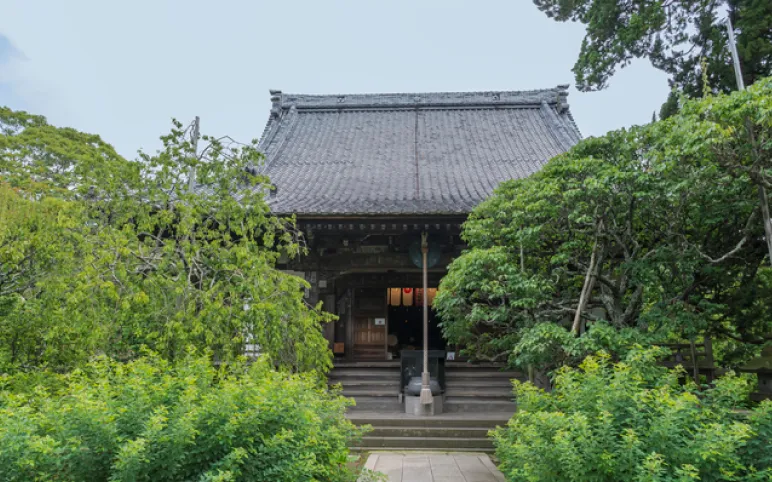
Hokaiji Temple
A sacred place that soothes the soul of the Hojo family, coloring the history of Kamakura
This is a Tendai sect temple founded by Takauji Ashikaga in the mid-14th century, and was built to mourn the spirits of the Hojo clan who died during the invasion of Kamakura after the fall of the Kamakura Shogunate. The principal image is Jizo Bodhisattva, the guardian deity of child rearing and sutra reading, and has been designated as a national important cultural property. On the grounds is the Taishi-do Hall, which enshrines Prince Shotoku, and is a quiet hideaway in Kamakura, known for its seasonal flowers, especially the beauty of the hagi. Combining history and natural beauty, this temple offers a peaceful solace to its visitors.
-
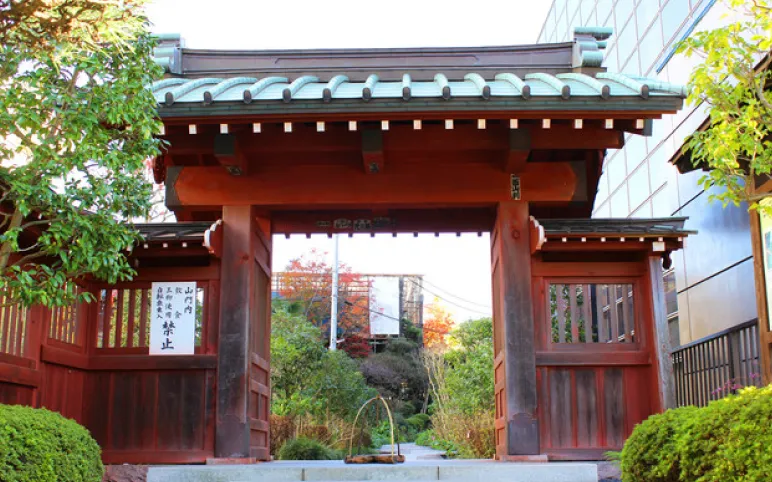
Daikoji Temple (Onmesama)
A garden where prayers for safe childbirth resound
Four seasons at Daikoji TempleDaigyōji is a special temple in Kamakura known for praying for safe childbirth, and is affectionately known as ``Onmesama.'' Famous for its beautiful gardens filled with seasonal flowers, this place is steeped in the history of Minamoto no Yoritomo, and even after converting to the Nichiren sect, pregnant women from all over the country still visit this place thanks to Onmesama, who is deeply worshiped as the god of safe childbirth. will come. Conveniently located just 3 minutes from Kamakura Station, it continues to provide a place of peace and prayer for visitors.
-
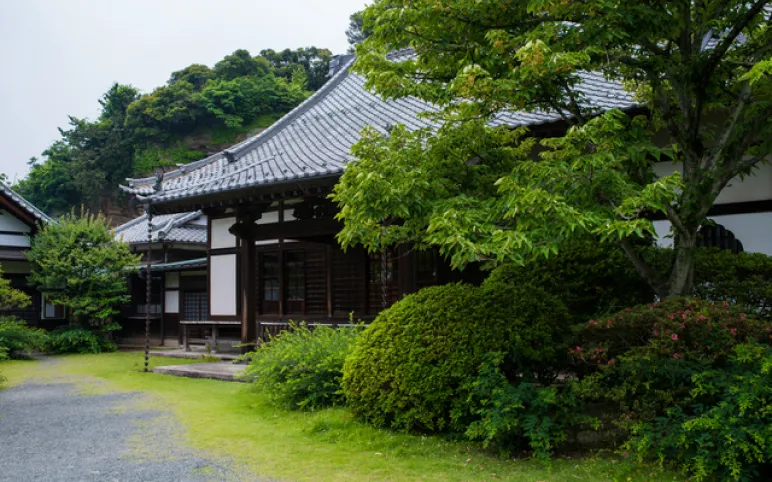
Jokomyoji Temple
A guardian temple of Kamakura that has been handed down through the ages.
It is a historic temple that advocates learning the teachings of various Buddhist sects, and was deeply involved in the history of the Kamakura and Muromachi shogunates, and was supported by the powerful people of the time. It holds valuable treasures such as the Amida Triad and the Yahiro Jizo, both of which are important cultural properties of the country, and there are graves and Amiki Jizo from the Kamakura period in the back mountain, allowing visitors to enjoy the good old days of Kamakura. It leaves a deep impression on the people who visit it as a place that conveys the message.
-
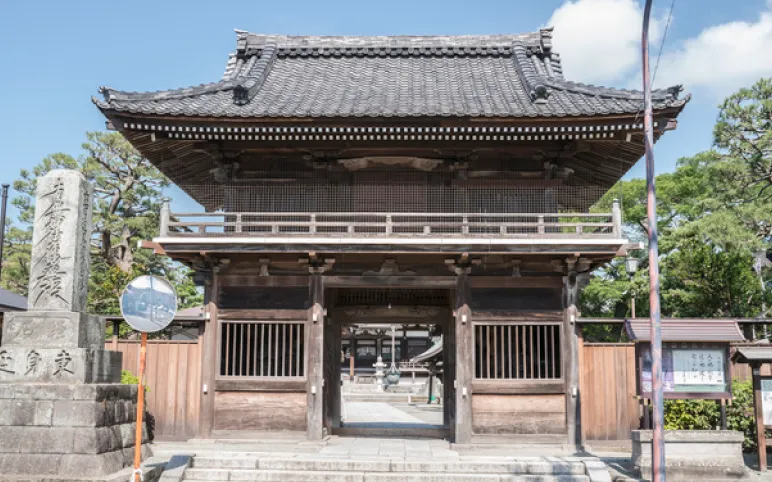
Hongakuji Temple
Guardian of Kamakura that transcends time
Prayer for business prosperity and marriageHongakuji Temple is a temple built on the site of Ebisu-do Temple, which was founded by Minamoto no Yoritomo. It enshrines Ebisu-sama, the god of business prosperity and marriage, and is an important base for spreading the teachings of Nichiren Buddhism. Beautiful wooden statues in the Song dynasty and Buddhist statues designated as cultural properties are enshrined here, and the temple is crowded with worshipers during the New Year and the festival on January 10th. It is a popular spot for its garden filled with seasonal flowers and the "Nigiri Fuku" that brings good luck.
-

Myohonji Temple
A Hidden Temple of Peace and History
Myohon-ji Temple is the oldest Nichiren temple, just a 10-minute walk from Kamakura Station. Despite its central location, it remains quiet and peaceful, with few tourists. Built in the early 13th century on the site of the fallen Hiki clan, it is surrounded by lush greenery and seasonal flowers, especially stunning during cherry blossom and flowering crabapple seasons. The temple grounds feature a statue of Nichiren and Jakushidō Hall, which honors those lost in the Hiki Rebellion. It also houses several Important Cultural Properties. Visitors can join a sutra-copying experience by reservation, making Myohon-ji a hidden gem in Kamakura.
-
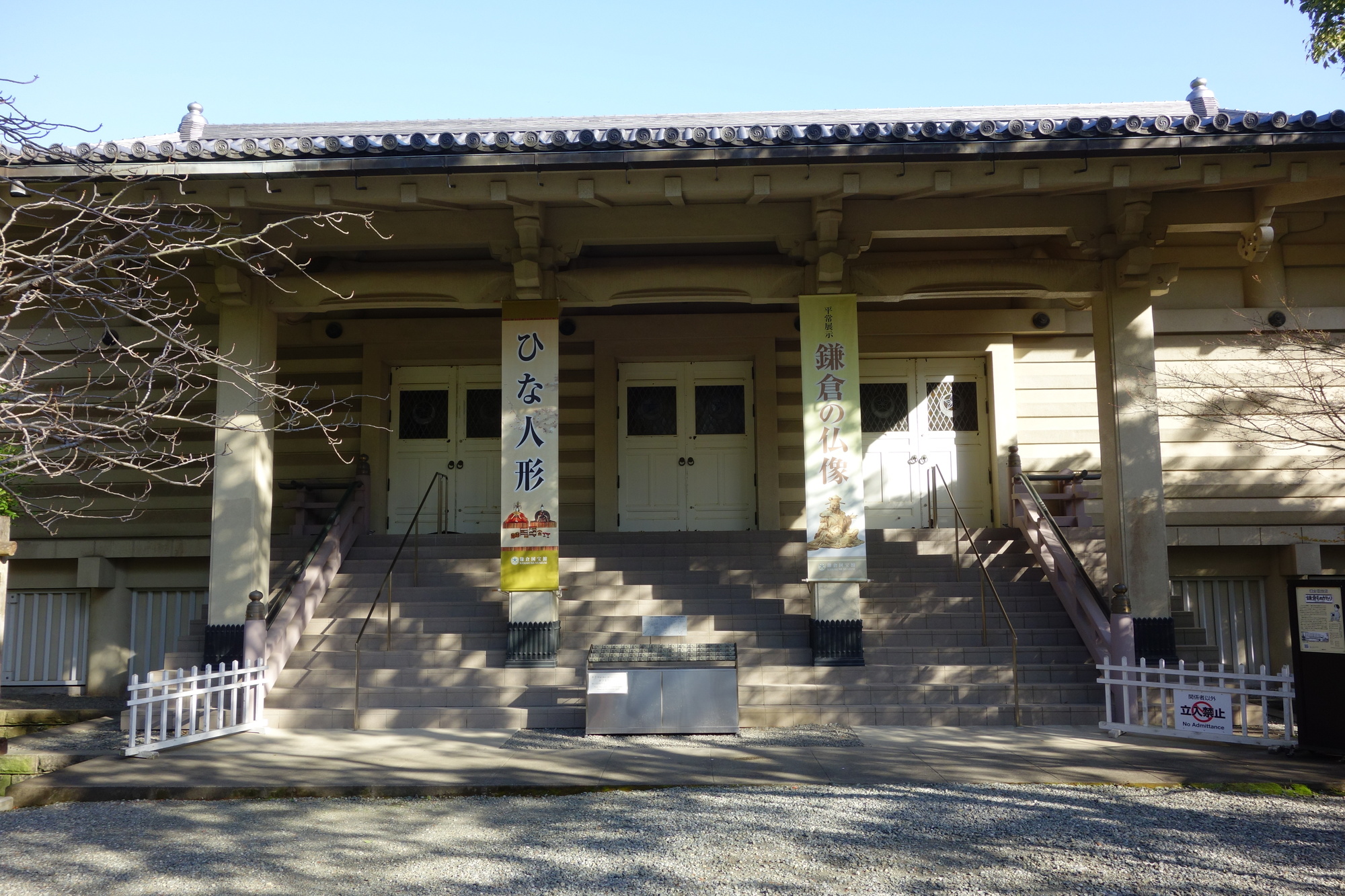
Kamakura Museum of National Treasures
Experience the Power of Buddhist Statues and National Treasures
The Kamakura Museum of National Treasures was established in 1928, inspired by the lessons of the Great Kanto Earthquake. Located within the grounds of Tsurugaoka Hachimangu Shrine, the museum primarily displays national treasures and important cultural properties from the Kamakura to Muromachi periods. Visitors can admire Buddhist statues up close, without glass cases, allowing them to fully experience their overwhelming presence in a historic architectural setting. This is a unique cultural spot to explore the depth of Japan’s religious heritage.
-
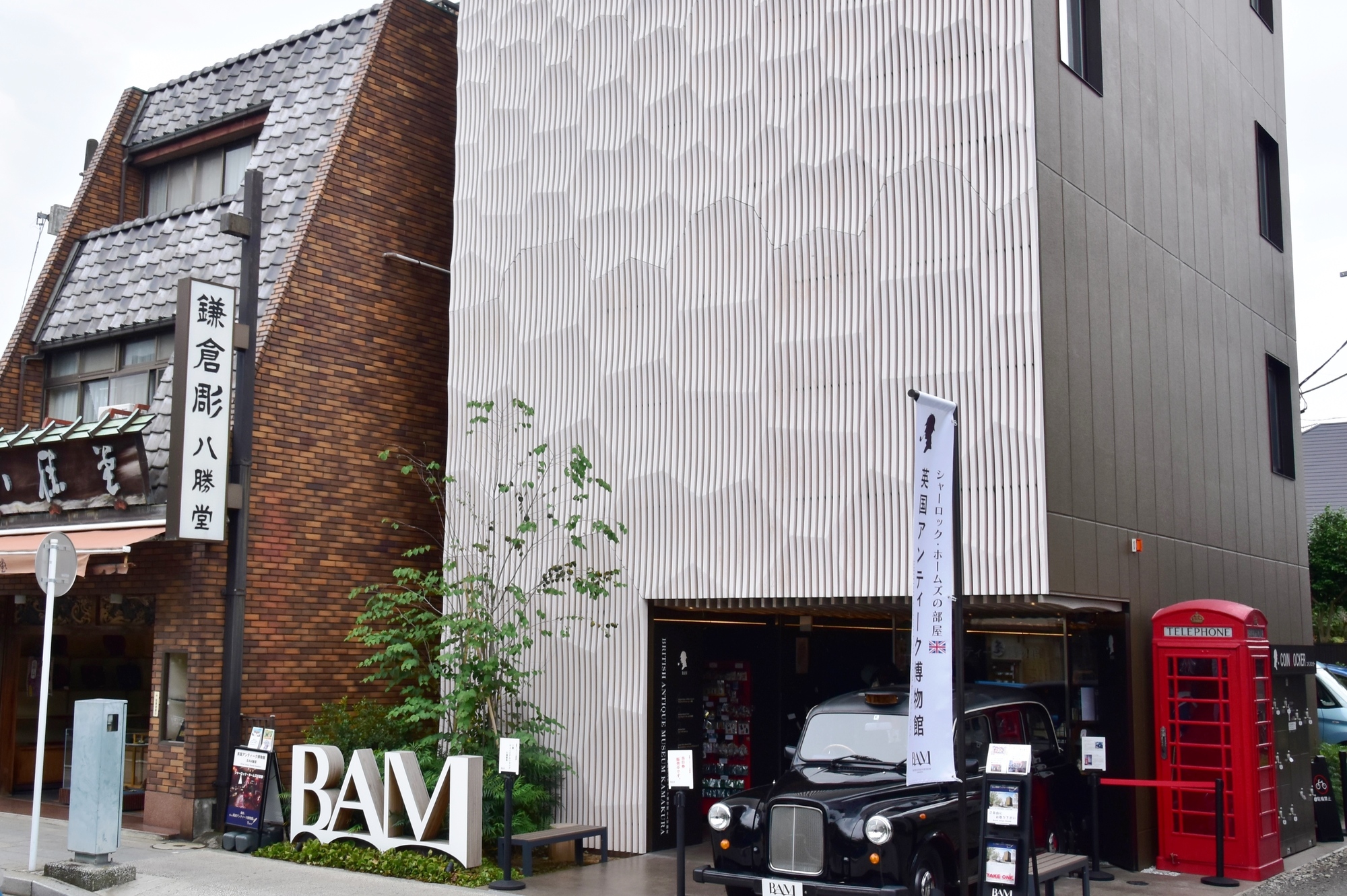
British Antique Museum BAM Kamakura
Timeless British Beauty Nestled in Kamakura
The British Antique Museum BAM Kamakura blends the historical charm of Kamakura with the refined elegance of British antiques. Designed by renowned architect Kengo Kuma, the building features a striking exterior made of Japanese cypress, reminiscent of traditional Kamakura woodcraft. Inside, visitors can explore intricately recreated Victorian-era interiors, including a detailed replica of “Sherlock Holmes’ Room,” offering an immersive, time-travel-like experience. Just a short walk from Kamakura Station, the museum introduces a new dimension to Kamakura’s cultural appeal, where Japanese and British aesthetics harmonize with the changing seasons.
